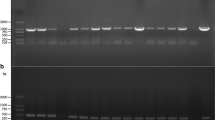Abstract
A new binary vector encoding for Candida albicans dihydrofolate reductase (DFR1) has been constructed and used as a dominant selectable marker for plant transformation. Transgenic tobacco plants with an increased resistance to methotrexate (Mtx) were obtained by co-transformation of tobacco leaf discs with Agrobacterium tumefaciens strains carrying two new binary vectors: pTI20 and pTI18. Co-transformants of Nicotiana tabacum were directly selected for and rooted on medium containing both kanamycin (kan) and Mtx. Leaf discs of transgenic plants were assayed for capacity of regeneration at different Mtx concentrations. Analysis of transcripts was performed on total RNA extracted from two Mtx-resistant plants. The transgenic plants increased resistance to Mtx can be explained by the exceptionally low capacity of Mtx to bind C. albicans dihydrofolate reductase, accountable by the presence of two amino acid residues strategically important in Mtx binding.
Similar content being viewed by others
References
Baccanari DP, Stone D, Kuyper L: Effect of a single amino acid substitution on Escherichia coli dihydrofolate reductase catalysis and ligand binding. J Biol Chem 256: 1738–1747 (1981).
Baccanari DP, Tansik RL, Joyner SS, Fling ME, Smith PL, Freisheim JH: Characterization of Candida albicans dihydrofolate reductase. J Biol Chem 264: 1100–1107 (1989).
Becker D, Kemper E, Schell J, Masterson R: New plant binary vectors with selectable markers located proximal to the left T-DNA border. Plant Mol Biol 20: 1195–1197 (1992).
Bogani P, Simoni A, Bettini P, Mugnai M, Pellegrini MG, Buiatti M: Genome flux in tomato auto and auxotrophic cell cones cultured in different auxin/cytokinin equilibria. I. DNA multiplicity and metylation levels. Genome 38: 902–912 (1995).
Bullock WO, Fernandez JM, Short JM: A high efficiency plasmid transforming recA Escherichia coli strain with betagalactosidase selection. BioTechniques 5: 376 (1987).
Daly S, Mastromei G, Yacoub A, Lorenzetti R: Sequence of a dihydrofolate reductase-encoding gene from Candida albicans. Gene 147: 115–118 (1994).
Doyle J, Doyle J.: Isolation of plant DNA from fresh tissue. Focus 1: 13–15 (1989).
Eichholtz DA, Rogers SG, Horsch RB, Klee HJ, Hayford M, Hoffmann NL, Bradford SB, Fink C, Flick J, O'Connell KM, Fraley RT: Expression of mouse dihydrofolate reductase gene confers methotrexate resistance in transgenic petunia plants. Somatic Cell Mol Genet 13: 67–76 (1987).
Franceschi M, Denaro M, Irdani T, Lorenzetti R, Mastromei G, Skarmoutsou E, Polsinelli M: A dihydrofolate reductase gene from Candida albicans molecular cloning. FEMS Microbiol Lett 80: 179–182 (1991).
Freisheim JH, Matthews DA: In: Sirotnak FM, Burchall JJ, Ensminger WB, Montgomery JA (eds) Folate antagonists as Therapeutic Agents, vol. 1, pp. 69–131. Academic Press. New York (1983).
Guarente L, Mason T: Heme regulates transcription of the CYC1 gene of S. cerevisiae via an upstream activation site. Cell 32: 1279 (1983).
Guerineau F, Brooks L, Meadows J, Lucy A, Robinson C, Mullineaux P: Sulfonamide resistance gene for plant transformation. Plant Mol Biol 15: 127–136 (1990).
Habert DA, Beverley SM, Kiely ML, Schimke RT: Properties of an altered dihydrofolate reductase encoded by amplified genes in cultures mouse fibroblasts. J Biol Chem 256: 9501–9510 (1981).
Herrera-Estrella L, De Block M, Messens E, Hernalsteens JP, Van Montagu M, Schell J: Chimeric genes as dominant selectable markers in plant cells. EMBO J 2: 987–995 (1983).
Hoekema A, Hirsch PR, Hooykaas PJJ, Schilperoort RA: A binary vector strategy based on separation of the Vir-and Tregion of the Agrobacterium tumefaciens Ti-plasmid. Nature 303: 179–180 (1980).
Horsch RB, Fry JE, Hoffmann NL, Walbroth N, Eichholtz D, Rogers SG, Fraley RT: A simple and general method for transferring genes into plants. Science 227: 1129–1331 (1985).
Jantzen HM, Strahle U, Gloss B, Stewart F, Schmid W, Boshart M, Miksicek R, Schutz G: Cooperativity of glucocorticoid response elements located far upstream of the tyrosine aminotransferase gene. Cell 49: 29–38 (1987).
Jefferson RA, Kavanagh TA, Bevan MW: GUS fusions: β-glucuronidase as a sensitive and versatile gene fusion marker in higher plants. EMBO J 6: 3901–3907 (1987).
Linsmaier AM, Skoog F: Organic growth factor requirements of tobacco tissue culture. Physiol Plant 18: 100–127 (1965).
Little JG, Haynes RH: Isolation and characterization of yeast mutants auxotrophic for 20-deoxythimidine 5′-monophosphate. Mol Gen Genet 168: 141–151 (1979).
Luzzati M: Isolation and properties of a thimidylate-less mutant in Saccharomyces cerevisiae. Eur J Biochem 79: 533–538 (1975).
Masterson RV, Furtek DB, Grevelding C, Schell J: A maize Ds transposable element containing a dihydrofolate reductase gene transposes in Nicotiana tabacum and Arabidopsis thaliana. Mol Gen Genet 219: 461–466 (1989).
Meijer EGM, Schilperoort RA, Rueb S, van Os-Ruygrok PE, Hensgens LAM: Transgenic rice cell lines and plants: expression of transferred chimeric genes. Plant Mol Biol 16: 807–820 (1991).
Perez P, Tiraby G, Kallerhoff J, Perret J: Phleomycin resistance as a dominant selectable marker for plant cell transformation. Plant Mol Biol 13: 365–373 (1989).
Ratnam S, Delcamp TJ, Hynes JB, Freisheim JH: Purification and characterization of dihydrofolate reductase from soybean seedlings. Arch Biochem Biophys 255: 279–289 (1987).
Rogers SG, Klee H, Horsch RB, Fraley RT: Use of cointegrating Ti plasmid vectors. In: Gelvin SB, Schilperoort RA, Verma DPS (eds) Plant Molecular Biology Manual, pp. A2: 1–12. Kluwer Academic Publishers, Dordrecht, Netherlands (1988).
Rose MD, Winston F, Hieter P: Methods in Yeast Genetics: Laboratory Course Manual. Cold Spring Harbor Laboratory Press, Cold Spring Harbor, NY (1991).
Sambrook J, Fritsch EF, Maniatis T: Molecular Cloning: A Laboratory Manual, 2nd ed. Cold Spring Harbor Laboratory Press, Cold Spring Harbor, NY (1989).
Schena M, Yamamoto KR: Mammalian glucocorticoid receptor derivatives enhance transcription in yeast. Science 241: 965–967 (1988).
Zeilkson R, Luzzati M: Mitochondrial and cytoplasmic distribution in Saccharomyces cerevisiae of enzymes involved in folate-coenzyme-mediated one carbon-group transfer. A genetic and biochemical study of the enzyme deficiencies in mutants tmp3 and ade3. Eur J Biochem 79: 285–292 (1977).
Author information
Authors and Affiliations
Rights and permissions
About this article
Cite this article
Irdani, T., Bogani, P., Mengoni, A. et al. Construction of a new vector conferring methotrexate resistance in Nicotiana tabacum plants. Plant Mol Biol 37, 1079–1084 (1998). https://doi.org/10.1023/A:1006082815434
Issue Date:
DOI: https://doi.org/10.1023/A:1006082815434




